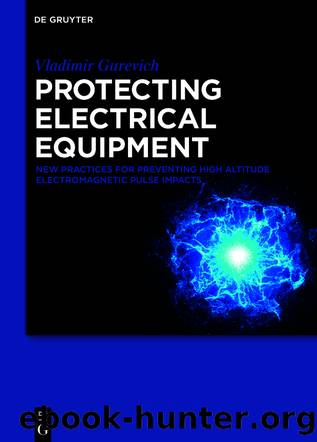Protecting Electrical Equipment by Vladimir Gurevich

Author:Vladimir Gurevich
Language: eng
Format: epub
Publisher: De Gruyter
Published: 2021-02-22T10:27:12.316000+00:00
9.2
Analysis of the literature
There are several publications that study sources of high-frequency electromagnetic pulses at power industry facilities and their influence on a DPR [2], [3], [4], [5], [6]. It should be noted that these publications discuss Japanese DPRs and the issues of the power industry in Japan. I could not find any information regarding European DPRs. Moreover, regardless of my personal extensive work experience in the power industry, I did not come across any significant issues with DPR protection during operation of high-voltage switching equipment in gas-insulated substations.
It is weird to read that the use of such simple tools, such as ferrite filters on control cables and additional absorbing capacitors on input terminals of a DPR and the printed circuit board of a CPU [3], solved the problem of DPRâs resistance to this kind of electromagnetic impact. One can assume that a Japanese DPR does not have any electromagnetic filters and circuits that suppress noise. Another strange thing is that Japan adopted a new standard of test pulses for a DPR, where the amplitude of high-frequency test pulses was reduced from 4âkV [7] to 1âkV [8], with simultaneous modification of their shape. Thus, the standard stipulates that test pulses should be rectangular and should have a rise time of 1âns and a pulse width of 100âns (1/100âns), instead of a so-called quick nanosecond pulse featuring 5/50âns according to [7]. Some publications of Japanese authors suggest that adoption of this standard has improved noise resistance of Japanese DPRs. At the same time, they do not address the issue of the source of these pulses: In other words, they do not mention the necessity to build special testing equipment and use it instead of available tools for standard tests. In addition to that, there are no data about comparison tests of DPRs and their responses to standard (5/50âns) pulses and 1/100âns pulses offered by Japan author. Without these comparison tests, the use of the Japanese standard for testing low-amplitude (four times lower) pulses and the insignificant differences in terms of speed of rise and length is questionable. This is especially true because in real conditions the noise signal arrives at the DPRâs input terminals via rather long cables, featuring apparent inductance for nanosecond pulses and thus largely affecting their shape. Thus, a 1/100âns pulse is unlikely to differ from a 5/50âns pulse at the DPRâs input terminal.
Download
This site does not store any files on its server. We only index and link to content provided by other sites. Please contact the content providers to delete copyright contents if any and email us, we'll remove relevant links or contents immediately.
| Automotive | Engineering |
| Transportation |
Machine Learning at Scale with H2O by Gregory Keys | David Whiting(4183)
Never by Ken Follett(3791)
Urban Outlaw by Magnus Walker(3342)
OPNsense Beginner to Professional by Julio Cesar Bueno de Camargo(3251)
Sapiens and Homo Deus by Yuval Noah Harari(2987)
Will by Will Smith(2793)
A Short History of Nearly Everything by Bryson Bill(2629)
Hooked: A Dark, Contemporary Romance (Never After Series) by Emily McIntire(2502)
Rationality by Steven Pinker(2291)
Borders by unknow(2229)
The Becoming by Nora Roberts(2088)
Holy Bible (NIV) by Zondervan(2087)
The One Percenter Encyclopedia by Bill Hayes(1787)
HBR's 10 Must Reads 2022 by Harvard Business Review(1777)
Freedom by Sonny Barger(1771)
A Short History of War by Jeremy Black(1762)
Five Ways to Fall by K.A. Tucker(1700)
Go Tell the Bees That I Am Gone by Diana Gabaldon(1687)
Girls Auto Clinic Glove Box Guide by Patrice Banks(1685)
